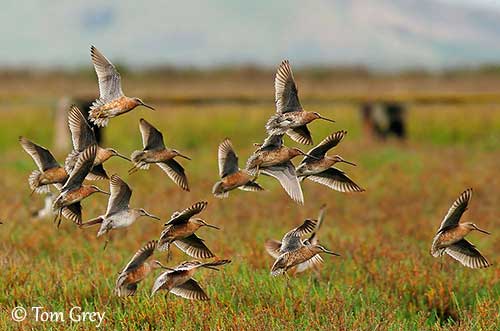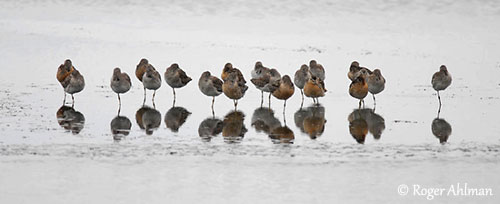
Fr: Bécassin roux - Bécassin à bec court
Ang: Short-billed Dowitcher
All: Kleiner Schlammläufer
Esp: Agujeta Gris
Ita: Limnodromo grigio
Nd: Kleine Grijze Snip
Sd: mindre beckasinsnäppa
Photographers:
Roger Ahlman
Pbase Galleries Peru and Ecuador & My bird pictures on IBC
Tom Grey
Tom Grey's Bird Pictures & Tom Grey's Bird Pictures 2
Text by Nicole Bouglouan
Sources:
HANDBOOK OF THE BIRDS OF THE WORLD Vol 3 by Josep del Hoyo-Andrew Elliott-Jordi Sargatal - Lynx Edicions - ISBN: 8487334202
SHOREBIRDS by Peter Hayman, John Marchant and Tony Prater – Christopher Helm – 1986 – ISBN: 0747014035
GUIDE DES LIMICOLES de D. Taylor - Delachaux et Niestlé - ISBN: 2603014080
THE HANDBOOK OF BIRD IDENTIFICATION FOR EUROPE AND THE WESTERN PALEARCTIC by Mark Beaman, Steve Madge - C. Helm - ISBN: 0713639601
All About Birds (Cornell Lab of Ornithology)
The Birds of North America online
Bird Web (Seattle Audubon Society)
Wikipedia, the free encyclopaedia
Advances in the Field Identification of North American Dowitchers
Conserve Wildlife - New Jersey Endangered and Threatened Species Field Guide
Short-billed Dowitcher
Limnodromus griseus
Charadriiformes Order – Scolopacidae Family
INTRODUCTION:
The Short-billed Dowitcher and the Long-billed Dowitcher were the same species until 1950, because they are very similar in appearance. The name “short-billed” was given to the present species only by comparison with the bill of the Long-billed Dowitcher. Both species differ mainly from each other in juvenile plumage.
The Short-billed Dowitcher breeds through Canada and winters on both E and W coasts of North, Central and South Americas. It frequents mudflats and tidal marshes, and can be seen around ponds, whereas it is mostly seen in coastal habitats on migration and during winter. This species feeds on small aquatic invertebrates and seeds, depending on the season. The nest is on the ground, often near water.
The Short-billed Dowitcher is not globally threatened, but the population trend is decreasing. However, numerous important wintering areas are still unknown and more information is needed.

Newly arrived in Ecuador
and resting in group
DESCRIPTION OF THE BIRD:
Biometrics:
Length: 25-29 cm
Wingspan: 45-51 cm
Weight: 65-154 gr
Bill length: 51-68 mm
The Short-billed Dowitcher in breeding plumage has mottled brown, black and gold upperparts. The feathers of mantle and scapulars have black centres and pale rusty or cinnamon fringes. The tertials are more barred. The wing-coverts are grey-brown with pale edges. At rest, the wingtip reaches the tail tip or extends slightly beyond it.
Back and upper rump are white, well visible in flight. Lower rump and uppertail-coverts are white with dark brown barring. The tail shows variable brown and white bars.
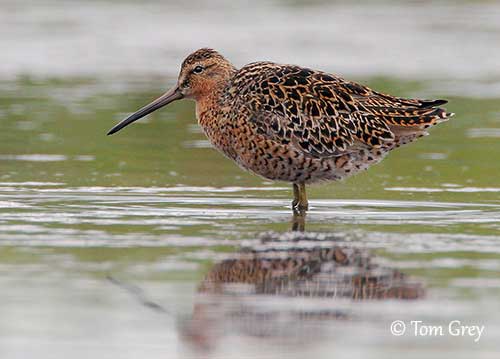
On the underparts, neck and breast are tinged pale chestnut-red. Belly and vent may be similar or whitish. Variable dark brown spotting and barring can be seen on breast, flanks and undertail-coverts. On the underwing, coverts and axillaries are white with faint brown bars.
On the head, the crown is dark brown with pale flecks and the supercilium is pale chestnut. A dark brown line extends from lores to behind the eye. Head sides are pale chestnut and slightly streaked brown. Nape and hindneck are pale chestnut to whitish with brown streaks.
The long bill (51-68 mm) is blackish-brown with paler base of lower mandible. The eyes are dark brown. Legs and feet are greyish to brownish-green.
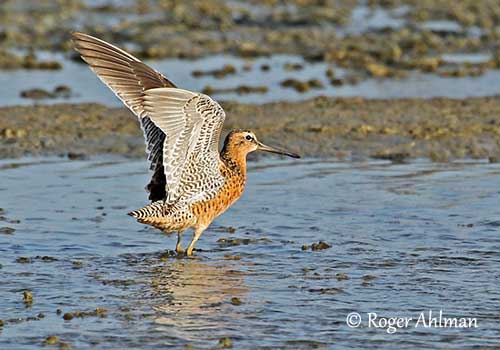
The Short-billed Dowitcher in non-breeding plumage has grey-brown crown, hindneck and upperparts with paler fringes. The underparts are mainly white, but throat and upper breast are slightly tinged greyish with fine, darker grey spots or streaks. Rear flanks and undertail-coverts are lightly spotted and barred.
On the head, the supercilium is whitish and the lores are slightly darker grey-brown.
Male and female have similar plumage, but she is slightly larger than male, with longer bill.
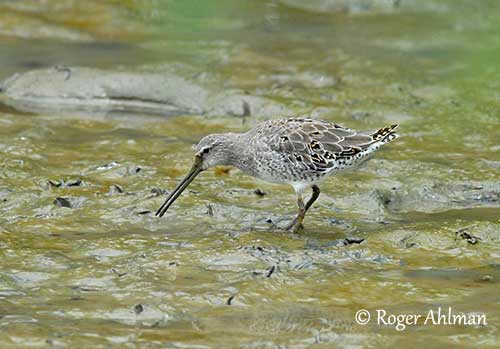
The juvenile has broad, chestnut-buff edges to feathers on crown and upperparts. The tertials are strongly barred brown and buff. This pattern is named “tiger-striped”. The underparts are buffish-white, but breast sides are tinged buff. Breast, flanks and undertail are finely streaked and spotted.
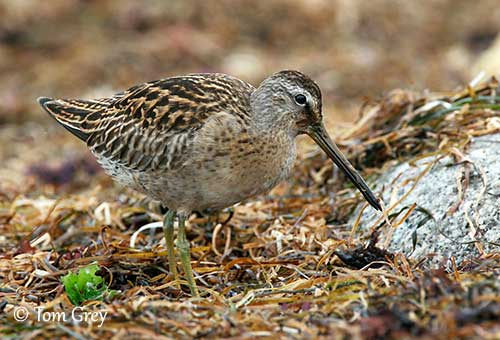
SUBSPECIES AND RANGE:
The Short-billed Dowitcher has three subspecies that differ mainly in size and breeding plumage. The average size increases from East to West.
L.g. caurinus breeds in S Alaska, S Yukon and NW British Columbia. It winters on the Pacific coasts from C USA to S Peru and Galapagos Islands.
This race is variable with pinkish-orange extending over belly. It is slightly larger.
L.g. hendersoni breeds in C Alberta to S Nunavut, C Manitoba and N Ontario. It winters from SE USA to Panama.
This race has reddish extending to undertail-coverts. The feathers of the upperparts show broader, rufous-buff edges. Breast sides are sparsely spotted and flanks are weakly barred.
L.g. griseus (described above) breeds in NE Canada from James Bay through C Quebec to W Labrador. It winters on Atlantic coast from S USA and West Indies to Brazil.
HABITAT:
The Short-billed Dowitcher breeds in wet bogs, often by pools and lakes, and in wet coastal tundra. On migration, it can be seen on inland and coastal wetlands, and it occasionally uses cultivated areas. During winter, it frequents mainly tidal mudflats with mangroves, sandy beaches and also saltmarsh pools.
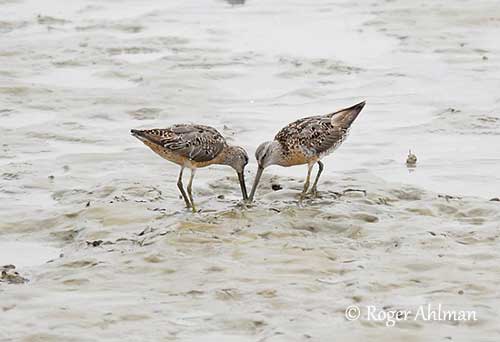
CALLS AND SONGS: SOUNDS BY XENO-CANTO
The Short-billed Dowitcher’s usual call is a rapid, mellow “tu-tu-tu” given when the bird is flushed or in flight. This call is very similar to the flight call of the Ruddy Turnstone.
The song is a prolonged gurgling of repeated “cha” notes ending in buzzing sound.
BEHAVIOUR IN THE WILD:
The Short-billed Dowitcher feeds on aquatic invertebrates such as insects and their larvae during the nesting period. At other times, molluscs, marine worms and crustaceans are part of its diet. It may also consume seeds of grasses and other aquatic plants species. In spring, it is known for its habit of eating eggs of horseshoe crab of family Limulidae.
The Short-billed Dowitcher usually feeds in water by submerging the head. It wades in shallow water and can be seen sometimes walking on wet mud while probing deeply with the bill. It feeds by rapid, vertical probing, like snipes. It often forages in large flocks.
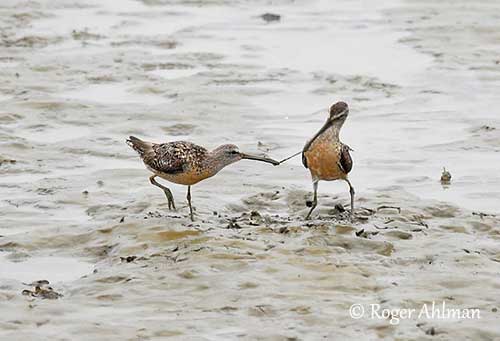
This species often roosts in large groups with other wader species. If disturbed, the bird stands motionless, holding the bill just below the water surface. But it may also dash away on powerful, swift flight.
The Short-billed Dowitcher performs aerial displays, a hovering flight over the territory accompanied by song. The male re-establishes the territory by singing, and occasionally, physical fights may occur against intruders.
The nest is on the ground and often near water. Both adults share the incubation, but the brood is usually raised by the male while the female leaves the breeding grounds. They are monogamous and the pair forms on the breeding grounds.
The Short-billed Dowitcher is a long-distance migrant, and the three races move southwards after breeding. The females leave from early July before males, and the juveniles move later. They reach N South America from mid-August to early October. The return spring migration occurs between early March and early June.
This species is a rare vagrant to W Europe and W Africa, E to Japan and S to Argentina and Chile.
The Short-billed Dowitcher has strong, swift flight with powerful, rapid wingbeats interspersed with long, rapid glides. They usually fly in single line and rarely in compact flock.
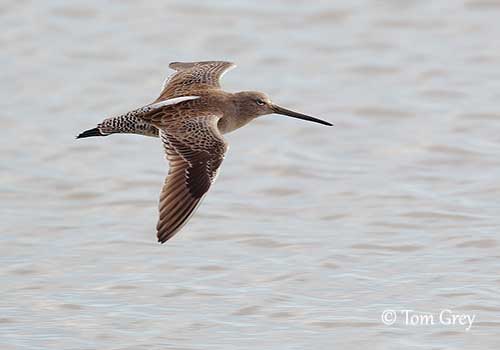
REPRODUCTION OF THIS SPECIES:
The breeding season takes place from late May to July.
The nesting areas are often far inland. The nest is on the ground, a shallow scrape in moss or in clump of grass. The shallow cup is lined with twigs, leaves and fine grasses. The nest site is usually in bog, forest clearing or edge of tundra, but often near water.
The female lays 3-5 olive-buff/brown eggs with brown markings. This species produces only one brood, but the pair may attempt a replacement clutch if the first is lost. Both adults incubate during about three weeks.
The downy chicks leave the nest soon after hatching. Usually, the female leaves the breeding grounds and the male alone tends the young. They are able to feed themselves. They fledge at 15-16 days old and start to migrate in late summer, but they usually remain into autumn.
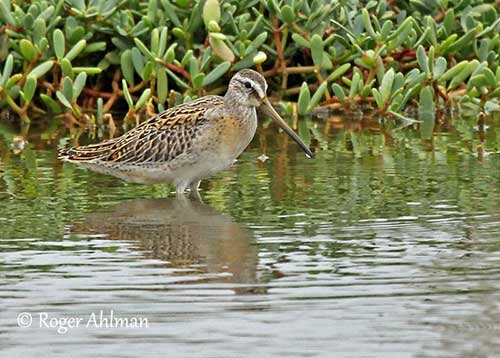
PROTECTION / THREATS / STATUS:
The Short-billed Dowitcher is not globally threatened for the moment, but there is a significant decline in all populations.
Usage of pesticide and habitat destruction are the main threats. Logging activity and commercial development have caused the fragmentation of the breeding habitat. Protection of the breeding grounds is the largest conservation priority.
The global population has been estimated to number 320,000 individuals, with 60,000 “hendersoni”, 110,000 “griseus” and 150,000 “caurinus”, but these estimations needs more information.
The Short-billed Dowitcher is currently evaluated as Least Concern.
